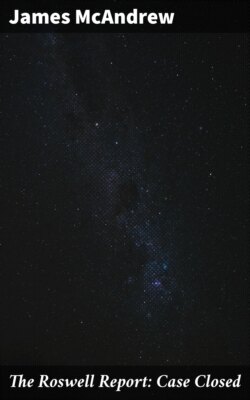Читать книгу The Roswell Report: Case Closed - James McAndrew - Страница 19
На сайте Литреса книга снята с продажи.
Interaction with Civilians
ОглавлениеIn several accounts, unsubstantiated allegations have been made that military personnel who retrieved equipment from rural areas of New Mexico intimidated and threatened civilians. Contrary to these charges, Balloon Branch personnel enjoyed good relations with the local community and often solicited their assistance in the area of a balloon or payload landing. In the flat, featureless desert areas of southeastern New Mexico near Roswell, the parachutes, payloads, the balloons themselves, and circling chase aircraft often drew crowds of curious onlookers from the local community. In fact, so many civilians were often present at balloon or payload landing sites, the scene was described by longtime civilian Balloon Branch recovery supervisor, Robert Blankenship, as being like the “circus coming to town.”[101]
Fig. 59. Bernard D. “Duke” Gildenberg (center) Balloon Branch Meteorologist, is shown here in May 1957 in front of the Man High I gondola. With Gildenberg are Man High I pilot Capt. Joseph W. Kittinger, Jr. (left), and Man High project scientist/pilot, Lt. Col. David G. Simons (MC). When Gildenberg attempted to inform UFO theorists that high altitude balloon projects were likely responsible for some of the UFO claims, his explanations were rejected, See also pages 8 & 9. (U.S. Air Force photo)
Allegations that civilians were threatened or told to “forget what they saw” are profoundly inaccurate. Threats, intimidation, or other types of misconduct by Balloon Branch personnel would have served no purpose since without the cooperation of local persons, many recoveries would not have been possible.[102]
Most balloon recoveries were coordinated in advance with local law enforcement agencies.[103] If a balloon or payload landed on private property and the owner could not be located, Balloon Branch operating instructions dictated that the local sheriff or police must be contacted.[104] In situations where local persons arrived at balloon landing sites before the recovery crews, they were simply asked to “step back” to allow recovery personnel to secure the balloon equipment.[105] If these persons inquired as to the purpose of a balloon flight, they were informed by technicians that it was a U.S. Air Force scientific study and were given a telephone number at Holloman AFB if they required additional information. At Holloman AFB, individuals qualified to answer detailed questions responded to these inquiries. There was never a reason to mislead or threaten individuals who observed balloon operations. Relations with local citizens were good, and Balloon Branch personnel and equipment were a common sight to residents in areas with high incidences of balloon operations.
Fig. 60. (Right) This ranch family assisted in the recovery of a Project Stargazer high altitude balloon payload and is shown here with a panel from the unmanned gondola. (U.S. Air Force photo)
In a few instances, situations arose when persons not familiar with the procedures and equipment used by the Balloon Branch misunderstood their activities. Such misunderstandings occurred several times during the 1970s and 1980s when recovery crews not only attracted the attention of local citizens while coordinating balloon recoveries, but also drew the attention of federal law enforcement agencies.[106]
Checks with the local sheriff revealed that the trucks and circling aircraft in the desert near Roswell were part of a balloon recovery mission, and not a drug smuggling operation. Apparently, balloon recoveries appeared to be something suspicious even to federal agents.
Fig. 61. A typical Holloman Balloon Branch recovery crew is shown here with a man known as “The hermit” who assisted them in a balloon recovery northwest of Silver City, N.M. in the 1960s. (photo collection of Robert Blankenship)
Fig. 62. A mule (named Ida) was borrowed from a local rancher when a balloon payload landed in difficult terrain 20 miles north of Wickenburg, Ariz. in October 1966. (U.S. Air Force photo)
Fig. 63. On occasion, Air Force balloon recovery crews rented or borrowed equipment from local residents. This bulldozer was rented for one recovery in the Sacramento mountains west of Roswell. (photo collection of Robert Blankenship)
Fig. 64. Balloon Branch vehicle at roadside café. This M-43 ¾-ton field ambulance, converted by the Holloman Balloon Branch into a communications vehicle, was a common sight in the areas surrounding Roswell during the 1950s and early 1960s. (photo collection of Ole Jorgeson)
Figs. 65 & 66. Examples of unusual payloads flown by Air Force high altitude balloons at Holloman AFB, N.M. (U.S. Air Force photos)
Fig. 67. (Left) This U.S. Army communications payload was flown at Holloman AFB, N.M. on September 30, 1976. (U.S. Army photo) Fig. 68. (Right) Payload launched by an Air Force high altitude balloon from Holloman AFB, N. M. on March 20, 1965. This payload was a scientific experiment for The Johns Hopkins University Astrophysics Laboratory. (U.S. Air Force photo)
Fig. 69. High altitude balloon payload launched from Holloman AFB on September 14, 1976. (U.S. Air Force photo)
